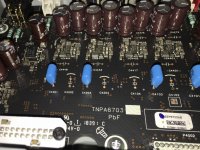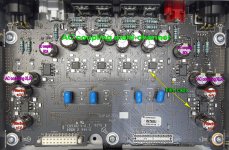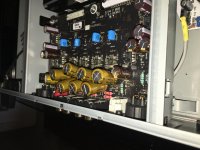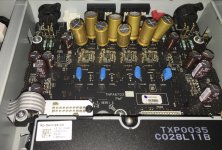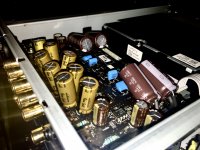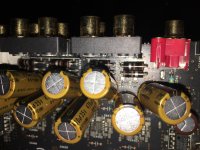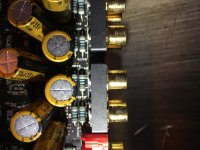Coris, hi
Would it be possible or advantageous to use a separate external power supply for the analogue board for example as an ultimate upgrade ?
Would it be possible or advantageous to use a separate external power supply for the analogue board for example as an ultimate upgrade ?
In my opinion, a such approach is not fortunate at all. An external PSU it involve long wires connections for DC lines. This is only bad and it favorise noises inducing. To not talk more about the aesthetical aspect... Definitely not good idea, as I can see...
My LPS is designed specifically to ensure protection against eventual noises, for the power lines dedicated to analogue circuits/board. Different windings on transformer, dedicated low noise regulators, as some many other measures to minimise any induced noises into the analogue power lines. Also similar measures are taken when upgrading the analogue sections residing on main board...
My LPS is designed specifically to ensure protection against eventual noises, for the power lines dedicated to analogue circuits/board. Different windings on transformer, dedicated low noise regulators, as some many other measures to minimise any induced noises into the analogue power lines. Also similar measures are taken when upgrading the analogue sections residing on main board...
I would like to mention too, about another aspect when using a linear/analogue power source to power a digital system. A digital system is natively very noisy while functioning. This is because the extremely high frequency involved and huge number of switching events at amazing speed. A such combination it generate a very large spectre of noises, spread all over, through the system connections, as wireless in the near environnement the system is functioning. This is true for any and every digital system, no matter its dimensions and complexity. Just add a switching power supply to all this noisy mess, and one can understand what the challenge is for the software and hardware to sort out and right processing the useful signals... Well, the system it works as it should and successfully in the end. Adding a analogue power device to a such noisy system, it make inevitable that the analogue (silent) power supply is strongly perturbed by the noises generated by the digital functionality. An linear power supply output measured while connected to a digital system in function, it look just horrible, even the same LPS it measured for few µV noises/ripple on bench tests (resistive loads). Therefore the good measurements results for an LPS it have no so much meaning, if that LPS is meant to be connected to an digital system. However, the noises measured to an LPS output while connected and powering a digital system in function, it have a different structure than when the powering is made by an SMPS (reduced spectre). Even thought all these noises aspects, there is very obvious that an LPS providing power to a digital system, it contribute very much to lowering the overall noise level of that whole system, while an SMPS it contribute to increasing it. There are different areas/fields of advantages when about LPS vs SMPS, as disadvantages in using such types PSUs. An compromise is always beneficial, and it have big impact over the quality of the outputted signals by that system/device.
Yes, moral of the story his that the lowest noise LPS has maybe not the nicest output connected to digital systems but nevertheless is way cleaner than the average SMPS. These are exactly my findings. It will never be perfect but LPS is in any way better than SMPS (for audio).
I would like to point out on an aspect (important issue) of the firmware of the UB9000, which it seems known to Panasonic, but for unexplainable reasons, they (still) ignore to fix it.
At questions about why this issue of this player model, their answer is “we do not know the cause of such” … Very strange answer from a manufacturer of a consumer devices sold to worldwide consumers/users.
Even more strange, Panasonic are not preoccupied to analyse their own software, trying to find out the cause of the reported issue, solving it, and updating in consequence the (more than an whole year old now) firmware of UB9000.
Well, what is this all about? In some (not yet clear) circumstances, while streaming from Youtube (I do not know yet if this issue it appears in streaming from other providers), the device just it freezes up. An event on network transfers it impact quite bad the whole device. The monitor gets dark (no video signal present), no any response from machine, nor from the buttons on front panels or from remote. Not possible to turn it off in any way, but only taking out the power cord.
It seems that the software/internal app, responsible for managing the network interface, it cannot respond or take a decision when the event it occur, and this it confuses the whole system. The device does not know what to do further. This is the apparency of the issue, seen from the user side.
I have tried to find some factual corelations when such issue it occurs. In my opinion it seems this issue in connection with a bad/poor software management of internal memory. The system it come to a point when it not has enough memory available to process any further. Or whatever… It could be many causes of such serious (never corrected) firmware bug.
Another software design problem of UB9000, in close connection with the above-mentioned issue, is the lack of possibility to proceed to a system reset (except taking out the power). This device it does not any general reset, but only at power up sequence, which it happens only when the device is connected to wall outlet. Then and always, the device it remains in standby like mode (similar to hibernation status for an PC), until it come the power on command from button or remote.
In this way, the device is not well/full “cleaned” up never, by a general reset, keeping one or another information in memory, registry, or wherever. The hardware in this device it seems it never get a full fresh/clean start up, except only when it loses the main power…
Where from my reasoning in this direction? When the issue occurred on my device, I taken out the network cable. After a while it was possible to turn it off (in standby). I start it up again, and I have tried accessing the network service. The device could not start up its network application, but only half way, and freeze it up again. For sure, it remembered the previous event, was still waiting something which never come (a response?), or it had not enough memory available to process further its network app. Or whatever… For sure, not any hardware reset occurred when cycled the standby on/off from front panel button. If the power is completely removed, then all it starts very well, as nothing it happened before (also the normal boot and power on sequence is running, starting with a general reset).
This device it not boots up, when the user it presses the power on button or from remote, but it only boots up when connected to outlet main power. In all the rest of the time when is “powered off” it goes in fact in a standby state. The bad quality software/firmware it is not able to fully clean memory and registry (as a hardware reset it does), and when waking up (“power on”), some parts of the system it still stores unnecessary or wrong informations, or the system memory is not properly cleaned up. They chose this like standby state, instead of power cut, because it speeds up the device start up when the user it press the power on button (or from remote). However, this so called power on function it still taking so unbearable long time...
Well, I have experienced network issues of the same sort (freezing up) at Oppo too, while streaming over network. Not on Youtube (there it is not working anymore that application), but on whatever streaming using the network interface in some particular (not very clear) circumstances. Only the whole behaviour is not so dramatic for Oppo players, as it is for UB9000. Because the Oppo devices it boots up in fact at power on (if set it accordingly in Menu), and then the power on sequence it begins always with a general hardware reset. This it makes the device “to forget” the whole previous bad things, starting up fresh and well. Long press function on power on button, if the device it freezes (Oppo software designers were clever to presume such freezing events occurrences), it makes possible a real power off (processor full power cut).
Oppo players it shows lot of problems, if the power off settings is set to something else than “Power Efficient” one.
This software issue is even more inconvenient (above to be highly annoying), when the UB9000 is equipped with an LPS. When the user gets an unresponsive device, while using it, the first gesture (instinct) is to take out its power completely (unplugging it from outlet). The second gesture it may come after a while as well… by selling the UB9000… But then, what buying else?
If for an SMPS, unplugging the device from main power it can be tolerated well enough, then for an LPS with large filtering capacities and long time to lose the accumulated power, it may be a challenge, such a cycling on/off main power. The analogue regulators inside an LPS it can be messed up by main power quick and repeated power on/off cycles. This is not good at all!
For those users heaving an LPS inside the UB9000, I would like to warn about this aspect. One should wait at least half a minute, before plugging in back again to wall outlet, after a such freezing event.
Another alternative to unplug the power cord, is to unplug first the network cable, then waiting for the device to respond at power off button (or remote).
I am thinking at a kind of hardware reset function/solution for UB9000, while using the LPS, but best of all it should be that Panasonic itself should have finally enough respect for those who are buying their products, fixing the bugs in their products software, as caring more for updating the devices firmware, for their customers’ convenience…
At questions about why this issue of this player model, their answer is “we do not know the cause of such” … Very strange answer from a manufacturer of a consumer devices sold to worldwide consumers/users.
Even more strange, Panasonic are not preoccupied to analyse their own software, trying to find out the cause of the reported issue, solving it, and updating in consequence the (more than an whole year old now) firmware of UB9000.
Well, what is this all about? In some (not yet clear) circumstances, while streaming from Youtube (I do not know yet if this issue it appears in streaming from other providers), the device just it freezes up. An event on network transfers it impact quite bad the whole device. The monitor gets dark (no video signal present), no any response from machine, nor from the buttons on front panels or from remote. Not possible to turn it off in any way, but only taking out the power cord.
It seems that the software/internal app, responsible for managing the network interface, it cannot respond or take a decision when the event it occur, and this it confuses the whole system. The device does not know what to do further. This is the apparency of the issue, seen from the user side.
I have tried to find some factual corelations when such issue it occurs. In my opinion it seems this issue in connection with a bad/poor software management of internal memory. The system it come to a point when it not has enough memory available to process any further. Or whatever… It could be many causes of such serious (never corrected) firmware bug.
Another software design problem of UB9000, in close connection with the above-mentioned issue, is the lack of possibility to proceed to a system reset (except taking out the power). This device it does not any general reset, but only at power up sequence, which it happens only when the device is connected to wall outlet. Then and always, the device it remains in standby like mode (similar to hibernation status for an PC), until it come the power on command from button or remote.
In this way, the device is not well/full “cleaned” up never, by a general reset, keeping one or another information in memory, registry, or wherever. The hardware in this device it seems it never get a full fresh/clean start up, except only when it loses the main power…
Where from my reasoning in this direction? When the issue occurred on my device, I taken out the network cable. After a while it was possible to turn it off (in standby). I start it up again, and I have tried accessing the network service. The device could not start up its network application, but only half way, and freeze it up again. For sure, it remembered the previous event, was still waiting something which never come (a response?), or it had not enough memory available to process further its network app. Or whatever… For sure, not any hardware reset occurred when cycled the standby on/off from front panel button. If the power is completely removed, then all it starts very well, as nothing it happened before (also the normal boot and power on sequence is running, starting with a general reset).
This device it not boots up, when the user it presses the power on button or from remote, but it only boots up when connected to outlet main power. In all the rest of the time when is “powered off” it goes in fact in a standby state. The bad quality software/firmware it is not able to fully clean memory and registry (as a hardware reset it does), and when waking up (“power on”), some parts of the system it still stores unnecessary or wrong informations, or the system memory is not properly cleaned up. They chose this like standby state, instead of power cut, because it speeds up the device start up when the user it press the power on button (or from remote). However, this so called power on function it still taking so unbearable long time...
Well, I have experienced network issues of the same sort (freezing up) at Oppo too, while streaming over network. Not on Youtube (there it is not working anymore that application), but on whatever streaming using the network interface in some particular (not very clear) circumstances. Only the whole behaviour is not so dramatic for Oppo players, as it is for UB9000. Because the Oppo devices it boots up in fact at power on (if set it accordingly in Menu), and then the power on sequence it begins always with a general hardware reset. This it makes the device “to forget” the whole previous bad things, starting up fresh and well. Long press function on power on button, if the device it freezes (Oppo software designers were clever to presume such freezing events occurrences), it makes possible a real power off (processor full power cut).
Oppo players it shows lot of problems, if the power off settings is set to something else than “Power Efficient” one.
This software issue is even more inconvenient (above to be highly annoying), when the UB9000 is equipped with an LPS. When the user gets an unresponsive device, while using it, the first gesture (instinct) is to take out its power completely (unplugging it from outlet). The second gesture it may come after a while as well… by selling the UB9000… But then, what buying else?
If for an SMPS, unplugging the device from main power it can be tolerated well enough, then for an LPS with large filtering capacities and long time to lose the accumulated power, it may be a challenge, such a cycling on/off main power. The analogue regulators inside an LPS it can be messed up by main power quick and repeated power on/off cycles. This is not good at all!
For those users heaving an LPS inside the UB9000, I would like to warn about this aspect. One should wait at least half a minute, before plugging in back again to wall outlet, after a such freezing event.
Another alternative to unplug the power cord, is to unplug first the network cable, then waiting for the device to respond at power off button (or remote).
I am thinking at a kind of hardware reset function/solution for UB9000, while using the LPS, but best of all it should be that Panasonic itself should have finally enough respect for those who are buying their products, fixing the bugs in their products software, as caring more for updating the devices firmware, for their customers’ convenience…
Last edited:
Hi Coris, is smaller value filter caps a workable solution? Otherwise a centralized reset with a powermonitoring IC giving a central reset to the various sections?
Sounds like a challenge 🙂
Sounds like a challenge 🙂
I do not think modifying the filtering capacities may be a solution. The filtering in a LPS it have to be solid, because it is about low frequency range. If the filtering capacity is under a certain level, then it affect the parameters of the LPS. Not a good way to go in my opinion...
The issue described above is not a power supply related, but pure firmware one. The software of the device it not work right in some circumstances. They who written that software can fix this, and they have to know what is going wrong. This it have to be corrected in normal conditions and by normal behaving companies. Oppo was used to care well about their customers... We can see what is happen in mobile phone world, computer world and so on. Why Panasonic cannot or do not want do the same for the product they manufacturer and sel it on wide market?
The hardware reset function is not simple function in a system. One need good documentation to implement a such, and making it function in the right way.
Such is a very big challenge when the datasheets and design details are not available...
The issue described above is not a power supply related, but pure firmware one. The software of the device it not work right in some circumstances. They who written that software can fix this, and they have to know what is going wrong. This it have to be corrected in normal conditions and by normal behaving companies. Oppo was used to care well about their customers... We can see what is happen in mobile phone world, computer world and so on. Why Panasonic cannot or do not want do the same for the product they manufacturer and sel it on wide market?
The hardware reset function is not simple function in a system. One need good documentation to implement a such, and making it function in the right way.
Such is a very big challenge when the datasheets and design details are not available...
I know but too large filter caps is an error often made. You are right that a centralized reset is a touch challenge when no information is available.
I have just noticed some pictures of the analogue board have some of the very small, .01 uF I think small blue caps, I can see places in the board for more and one picture shows them in place others, like mine missing any ideas on if these are worth fitting ?
The blue ceramic caps in slots either Side of the opamps ?
I have also seen some people replace these opamps with Texas ones any thoughts ?
The blue ceramic caps in slots either Side of the opamps ?
I have also seen some people replace these opamps with Texas ones any thoughts ?
Attachments
The caps marked on picture may be replaced for analogue sound improvements (AC coupling caps paralleled with 1µ film on back side).
The blue caps not necessary to be replace it. Please note that all the opamps on board are surrounded by film caps (good design!)
The blue caps not necessary to be replace it. Please note that all the opamps on board are surrounded by film caps (good design!)
Attachments
Last edited:
Coris, hi
I did upgrade the caps and swapped the resistors to Takman Carbon as well yesterday, the Nichicon FG were larger and whist it looks a little unauthodox seems to be okay, I will have a listen later today I have checked al works okay and left it playing
I invested in a reasonable desolder station so feeling more confident now ! I can add the 1uf film caps, Wima's ?
Do the filer caps work with multichannel ?
I did upgrade the caps and swapped the resistors to Takman Carbon as well yesterday, the Nichicon FG were larger and whist it looks a little unauthodox seems to be okay, I will have a listen later today I have checked al works okay and left it playing
I invested in a reasonable desolder station so feeling more confident now ! I can add the 1uf film caps, Wima's ?
Do the filer caps work with multichannel ?
Attachments
Last edited:
Filtering +/-V caps it are placed (decoupling) on +/-12v lines which it are common to stereo and multi-channel sections.
The AC coupling caps it should always be unipolar types for best results. 1µ Wima are good. These caps it should be soldered on the electrolytic ones terminals (parallel it).
The AC coupling caps it should always be unipolar types for best results. 1µ Wima are good. These caps it should be soldered on the electrolytic ones terminals (parallel it).
Last edited:
Tks, I’ll swap those out next weekend, I have some more Nichicon FG’s and some Elma Silmic II’s as well
Okay a few words on the cap changes, I did run a few hours through before assessing, I know some don't agree but the recommendation was 100 hours for the Silmics
Overall a small step forward, in some respect less than I was hoping, all done at the same time so I cant separate the Nichicon FG with the Elna Silmic II's and the Takman resistors. But overall :
1. Resolution and clarity has been improved, lower level detail is more obvious and easier to seperate, there is less 'smearing and haze' everywhere, not obvious before but a little more of everything
2. Tonality is better there is a sense of more 'colour' and naturalness in the sounds you here, voices in particular sound very real
3. A marginal improvement in projection and scale, the scene seems a little bigger and broader
4. Unsure about any dynamics improvement, certainly no worse
5. A reduction in 'edginess' and the occasional hardness, seems as if any minor compression is reduced so its easier to listen at high levels
I am trying to compare to other upgrades, its noticeable but not transformational. I will try swapping out the TAKMAN resistors to the much loved Allen Bradley, which might be a little noisy (hopefully not) but if they do improve the dynamics a bit and or add some more colour to the tonality (By colour I don't mean colouration I mean the range of tones and the clarity of tones) then I can try some other resistors if I hear any difference
It is sounding very good as a system at the moment though, so maybe I should leave alone !
I have tried some Belden 8412 cable in a few places and have gone back to sharkwire, so that experiment failed ! I am tempted to try some Duelund in a few placed but that adds up
Overall a small step forward, in some respect less than I was hoping, all done at the same time so I cant separate the Nichicon FG with the Elna Silmic II's and the Takman resistors. But overall :
1. Resolution and clarity has been improved, lower level detail is more obvious and easier to seperate, there is less 'smearing and haze' everywhere, not obvious before but a little more of everything
2. Tonality is better there is a sense of more 'colour' and naturalness in the sounds you here, voices in particular sound very real
3. A marginal improvement in projection and scale, the scene seems a little bigger and broader
4. Unsure about any dynamics improvement, certainly no worse
5. A reduction in 'edginess' and the occasional hardness, seems as if any minor compression is reduced so its easier to listen at high levels
I am trying to compare to other upgrades, its noticeable but not transformational. I will try swapping out the TAKMAN resistors to the much loved Allen Bradley, which might be a little noisy (hopefully not) but if they do improve the dynamics a bit and or add some more colour to the tonality (By colour I don't mean colouration I mean the range of tones and the clarity of tones) then I can try some other resistors if I hear any difference
It is sounding very good as a system at the moment though, so maybe I should leave alone !
I have tried some Belden 8412 cable in a few places and have gone back to sharkwire, so that experiment failed ! I am tempted to try some Duelund in a few placed but that adds up
Last edited:
With Covid 19 my postal service for my film library was so poor I suspended my account for one month to allow the postal service to improve.
This seemed to be the perfect opportunity to send my 9000 off to Coris to get the LPS and hdmi board upgrade, so I shipped it off.
I only use my 9000 for movies and streaming, (Netflix and Iplayer) so I wasn't interested in the analogue audio upgrade.
Throughout the process Coris kept me informed of progress and provided the odd picture to show how my 9000 was changing.
The entire process, including shipping, took around 4 weeks.
I packaged it well on it's outbound journey but Coris had it even better packaged with a cardboard cover over the unit, within it's box.
The unit is heavier now with the LPS in it and feels like a really solid piece of kit.
I've run the unit now for about a week, giving it a chance to bed in (and burn in). I know Coris doesn't approve of this term but as a long time audiophile I've come across this too many times to discount it.
So after about a week I turned to Lucy in 4K, probably one of the best discs to assess picture quality, it looked great, even better than I remembered.
Colours were very natural, but vibrant.
The shots of downtown Hong Kong looked extremely real.
Motion also seemed to have improved.
The cherry on the cake was the car chase scene through Paris, it looked phenomenal. Again It looked like you were there, rather than watching a scene.
There was also a solidity to the image that was very impressive.
In the end I stopped reviewing and just ended up enjoying the image.
Audio was more difficult to judge as I find that hdmi cables can make a big difference, don't let anyone tell you a cheap hdmi is as good as an expensive one and that's it's only 1's and 0's.
I run my system with dual hdmi, a fiber optic hdmi cable to my projector and I use a Belkin 8K ultrafast hdmi cable for audio. This cable gives excellent treble response and is very reasonably priced. I've had other cables, (premium certified too), were the top end was missing and the sound was dull and lifeless.
Sound via the hdmi upgrade is clean, clear, dialogue easy to follow and the treble well extended, but I feel there is more to come with the sound.
I also tried some Netflix streaming and watched In the Line of Fire, a Clint Eastwood movie from around 1993, I think.
This was a full screen image, 16:9 and I thought it looked better than it had a right to do, indoor scenes were bright and impressive, outdoor scenes very natural.
I also watched Days of Thunder on 4K blu-ray, the crowd shots were just a riot of colour.
All in all I'm very happy with the upgrade and I plan to keep my Coris modded 9000 for a very long time.
This seemed to be the perfect opportunity to send my 9000 off to Coris to get the LPS and hdmi board upgrade, so I shipped it off.
I only use my 9000 for movies and streaming, (Netflix and Iplayer) so I wasn't interested in the analogue audio upgrade.
Throughout the process Coris kept me informed of progress and provided the odd picture to show how my 9000 was changing.
The entire process, including shipping, took around 4 weeks.
I packaged it well on it's outbound journey but Coris had it even better packaged with a cardboard cover over the unit, within it's box.
The unit is heavier now with the LPS in it and feels like a really solid piece of kit.
I've run the unit now for about a week, giving it a chance to bed in (and burn in). I know Coris doesn't approve of this term but as a long time audiophile I've come across this too many times to discount it.
So after about a week I turned to Lucy in 4K, probably one of the best discs to assess picture quality, it looked great, even better than I remembered.
Colours were very natural, but vibrant.
The shots of downtown Hong Kong looked extremely real.
Motion also seemed to have improved.
The cherry on the cake was the car chase scene through Paris, it looked phenomenal. Again It looked like you were there, rather than watching a scene.
There was also a solidity to the image that was very impressive.
In the end I stopped reviewing and just ended up enjoying the image.
Audio was more difficult to judge as I find that hdmi cables can make a big difference, don't let anyone tell you a cheap hdmi is as good as an expensive one and that's it's only 1's and 0's.
I run my system with dual hdmi, a fiber optic hdmi cable to my projector and I use a Belkin 8K ultrafast hdmi cable for audio. This cable gives excellent treble response and is very reasonably priced. I've had other cables, (premium certified too), were the top end was missing and the sound was dull and lifeless.
Sound via the hdmi upgrade is clean, clear, dialogue easy to follow and the treble well extended, but I feel there is more to come with the sound.
I also tried some Netflix streaming and watched In the Line of Fire, a Clint Eastwood movie from around 1993, I think.
This was a full screen image, 16:9 and I thought it looked better than it had a right to do, indoor scenes were bright and impressive, outdoor scenes very natural.
I also watched Days of Thunder on 4K blu-ray, the crowd shots were just a riot of colour.
All in all I'm very happy with the upgrade and I plan to keep my Coris modded 9000 for a very long time.
Last edited:
Wow some very interesting results with a resistor change, not what I was expecting at all. The Allen Bradleys do seem to have a really natural tonality, they are warm and natural in a more analogue way, however they are just a little too recessed and they seem to slug upper mid dynamics in my set up. I love the tonality although the balance is a little too recessed losing a bit of film ambiance and to some extent physical scale seems reduced as well.
They have now had enough time to settle in and I have read the AB's starting a little dark and recessed and opening up after 20-30 hours. They have improved and are less recessed than they were, but the lack of upper mid dynamics and sense of scale means they will go.
Not sure what I will try next amazed just how much difference these resistors made
They have now had enough time to settle in and I have read the AB's starting a little dark and recessed and opening up after 20-30 hours. They have improved and are less recessed than they were, but the lack of upper mid dynamics and sense of scale means they will go.
Not sure what I will try next amazed just how much difference these resistors made
After a few conversations I decided to put in some Takman Rey resistors to replace the Allen Bradley. A quick listen and the balance is immediately back and am hopeful that they will be better than the REX in this setting. Initial impressions very positive I think they are better than the REX and certainly better than the AB's
I'll write up a full summary after a few hours of running in, so far so good
I'll write up a full summary after a few hours of running in, so far so good
Well the resistors have been back with the Takman Reys for a week and this is by far the best set so far. I am thinking of trying some Shinkoh, but cant buy 100 Ohm for the 8 signal resistors running to the RCA's. I assume these assist with the output impedance so dropping (I can buy 80 Ohm) might allow too much voltage to go through on the output and I'd run the possibility of clipping in the pre amp ?
I am really surprised how much difference they make
The Takman Rex were less dynamic in comparison (this seems top be a real strength of the Reys in this location) and although very good seemed a little reserved and polite, the AB's were just too recessed and 'thick' sounding with a lot of softeness and slowness to the overall presentation. However I really liked the lack of any glare or hardness and the in the room naturalness. The lack of resolution and lost ambiance was just way too great as well.
The Takman Rey are better than the Rex and AB in most areas. The low bass is superb the dynamics excellent, the are not cold thin or steely in any way, no glare or hardness but they do sound a little weaker in the lower mids, so some piano tracks sound a little lacking in comparison in certain harmonic overtones. They are really good and the best by a margin but I wonder if another hour with the soldering iron and some Shinkohs might be worth trying. I am still surprised just how much difference these resistors make.
I am really surprised how much difference they make
The Takman Rex were less dynamic in comparison (this seems top be a real strength of the Reys in this location) and although very good seemed a little reserved and polite, the AB's were just too recessed and 'thick' sounding with a lot of softeness and slowness to the overall presentation. However I really liked the lack of any glare or hardness and the in the room naturalness. The lack of resolution and lost ambiance was just way too great as well.
The Takman Rey are better than the Rex and AB in most areas. The low bass is superb the dynamics excellent, the are not cold thin or steely in any way, no glare or hardness but they do sound a little weaker in the lower mids, so some piano tracks sound a little lacking in comparison in certain harmonic overtones. They are really good and the best by a margin but I wonder if another hour with the soldering iron and some Shinkohs might be worth trying. I am still surprised just how much difference these resistors make.
Attachments
Last edited:
- Home
- Source & Line
- Digital Source
- Panasonic UB9000 - discussions, mods, improvements
